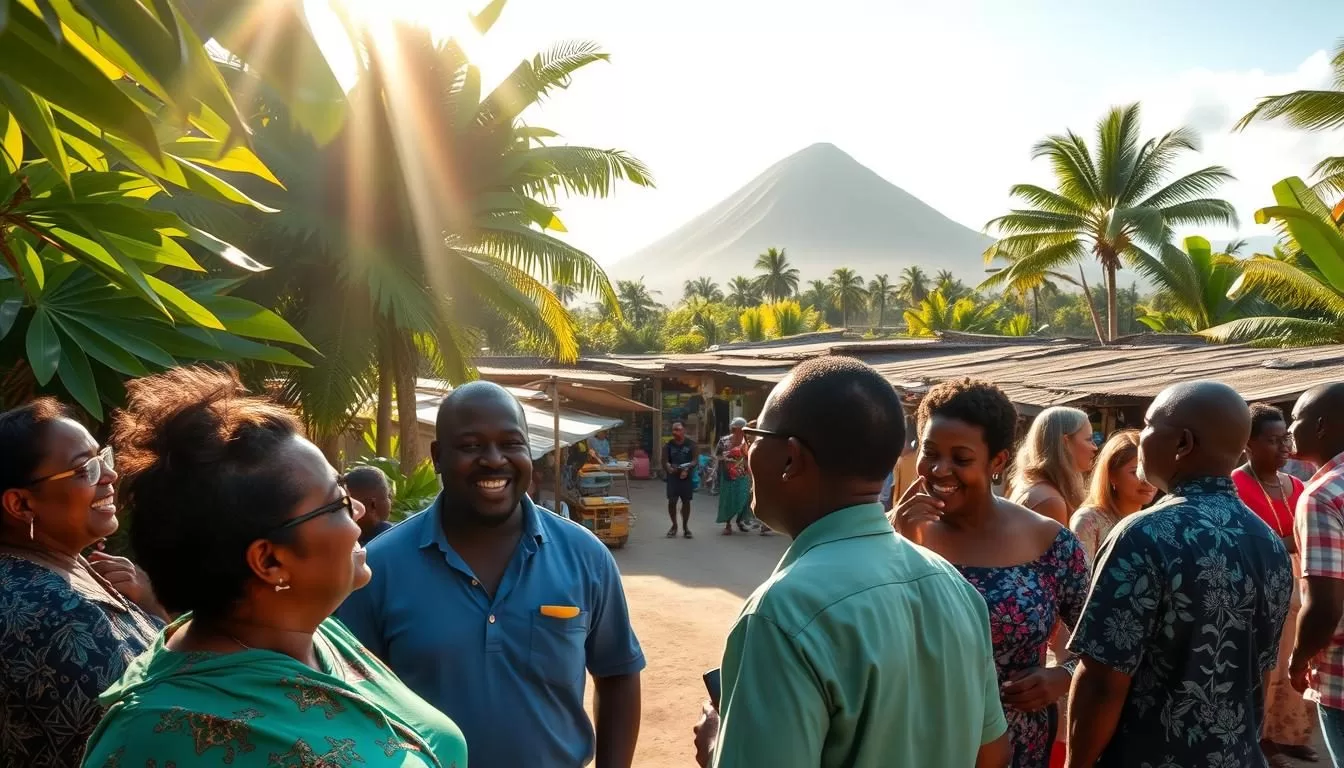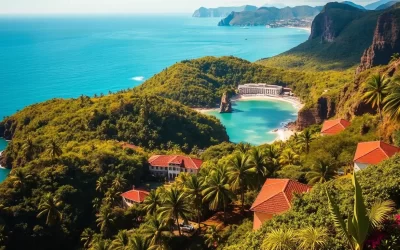✓ Accommodations ✓ Flights ✓ Rental Cars ✓ Tours & Activities
When you explore the vibrant culture of São Tomé and Príncipe, you’ll quickly notice how language plays a central role in shaping its identity. Portuguese is the official tongue, spoken by nearly 98.4% of the population, making it a unifying force across the islands. Over half of the residents use it as their first language, reflecting its deep-rooted presence in daily life.
Beyond Portuguese, the islands are home to rich creole variants like Forro, spoken by 36.2% of the population, and Angolar, used by 6.6%. These dialects are more than just ways of communication—they are windows into the islands’ history and cultural evolution. While some, like Principense Creole, are fading among younger generations, they remain vital to the older population.
Understanding these languages offers insight into the social fabric of São Tomé and Príncipe. They tell stories of resilience, adaptation, and unity, making them an essential part of the islands’ charm.
Introduction to São Tomé and Príncipe’s Linguistic Landscape
Nestled off the African coast, these islands boast a unique blend of languages shaped by their past. The country’s geographical location and colonial history have created a rich linguistic tapestry that reflects its diverse heritage.
Geographical and Historical Context
Located in the Gulf of Guinea, the island nation covers just 964 square kilometers, with São Tomé being the larger of the two main islands. Its tropical climate and volcanic terrain have influenced settlement patterns and cultural development. The Portuguese colonization in the 15th century introduced the official language, Portuguese, which remains dominant today.
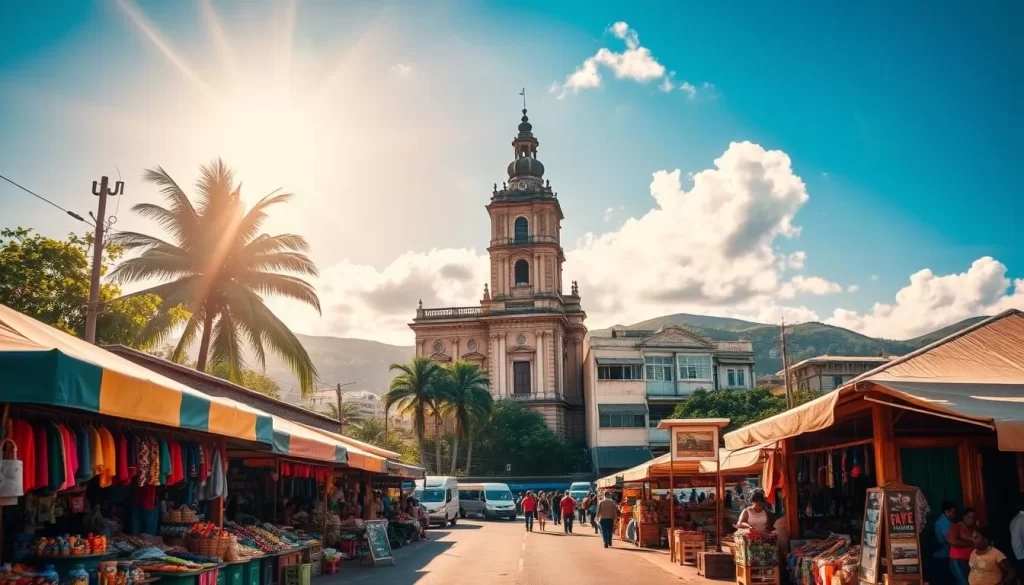
Over the centuries, the island’s multicultural demographics evolved, blending African, European, and creole influences. This mix gave rise to regional languages like Forro and Angolar, which are still spoken by significant portions of the population.
Demographic Insights on Language Use
With a population of around 220,372, the country showcases a fascinating distribution of languages. Portuguese is the primary language, used by nearly 98.4% of residents, while creole variants are more common in rural areas.
| Language | Percentage of Speakers |
|---|---|
| Portuguese | 98.4% |
| Forro Creole | 36.2% |
| Angolar Creole | 6.6% |
Urban areas, particularly the capital São Tomé, see higher Portuguese usage, while rural communities preserve creole traditions. This dynamic reflects the ongoing interplay between modernity and tradition in the country’s linguistic identity.
Sao Tome and Principe: Official and widely spoken languages
The linguistic landscape of São Tomé and Príncipe is a fascinating blend of tradition and modernity. Portuguese, the official language, is spoken by nearly 98% of the population, making it the primary means of communication across the islands. Its widespread use reflects its deep integration into daily life, from education to government.
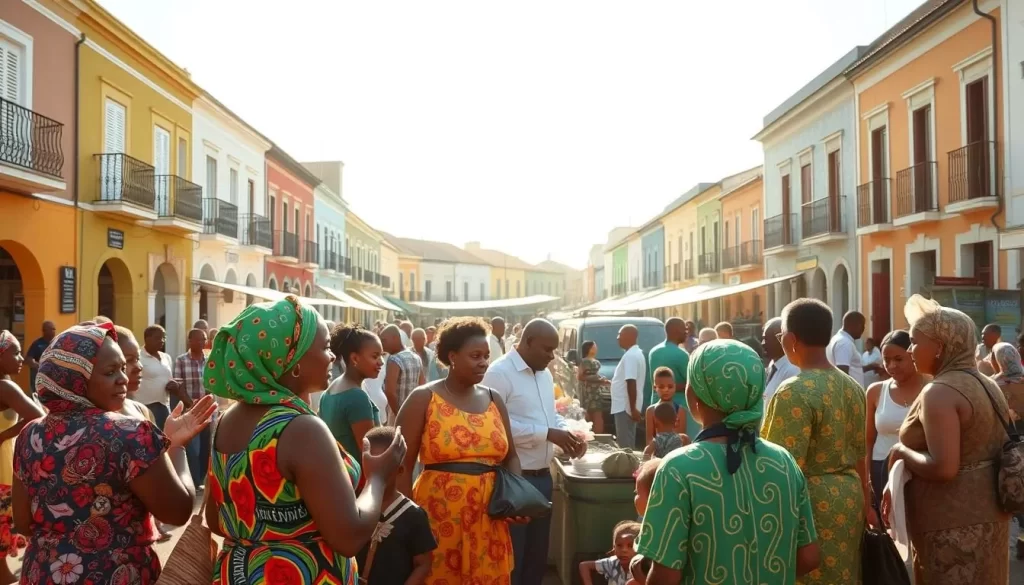
Understanding the Prevalence of Portuguese
Portuguese dominates the islands due to its colonial roots and its role as the medium of instruction in schools. With a literacy rate of around 90%, proficiency in Portuguese is high, especially among the younger generation. This ensures its continued relevance in urban areas and formal settings.
The Role of Creole Variants in Daily Life
While Portuguese is the official language, creole variants like Forro and Angolar hold significant cultural importance. Forro, spoken by 36.2% of the population, is a bridge between the islands’ African heritage and Portuguese influence. Angolar, used by 6.6%, is another example of the islands’ linguistic diversity.
These creole languages are more than just dialects—they are symbols of identity and resilience. They thrive in rural communities, where they serve as a vital link to the past. Despite challenges, efforts to preserve these languages highlight their enduring value in the islands’ cultural fabric.
Portuguese: The Dominant Language and Its Variants
Portuguese is more than just a language in São Tomé and Príncipe—it’s a cultural cornerstone. As the official language, it’s spoken by nearly 98.4% of the population, making it the primary means of communication. Its influence extends beyond daily conversations, shaping education, governance, and cultural expression.
Sao Tomean Portuguese: Heritage and Modern Usage
Sao Tomean Portuguese has evolved over centuries, blending traditional heritage with contemporary expressions. Its unique pronunciation, vocabulary, and grammar reflect the islands’ history and cultural influences. For example, certain words and phrases are distinct to the region, showcasing its local flavor.
Today, this variant thrives in both formal and informal settings. It’s used in schools, media, and everyday interactions, ensuring its continued relevance. Its adaptability highlights how language evolves while preserving its roots.
Comparing Similarities with Brazilian Portuguese
Sao Tomean Portuguese shares many similarities with Brazilian Portuguese, another prominent variant. Both feature softer pronunciations and unique regional vocabulary. However, Sao Tomean Portuguese retains distinct elements that set it apart.
Globally, Portuguese is the fifth-most spoken native language, with over 260 million speakers worldwide. This number underscores its significance as a global language. In São Tomé and Príncipe, it’s not just a means of communication—it’s a symbol of identity and unity.
Local Creole Languages: Forro, Angolar, and Principense
Forro, Angolar, and Principense creoles are more than dialects—they’re cultural treasures. These languages connect communities and preserve the islands’ unique heritage. Each creole tells a story of resilience, shaped by centuries of history and cultural exchange.
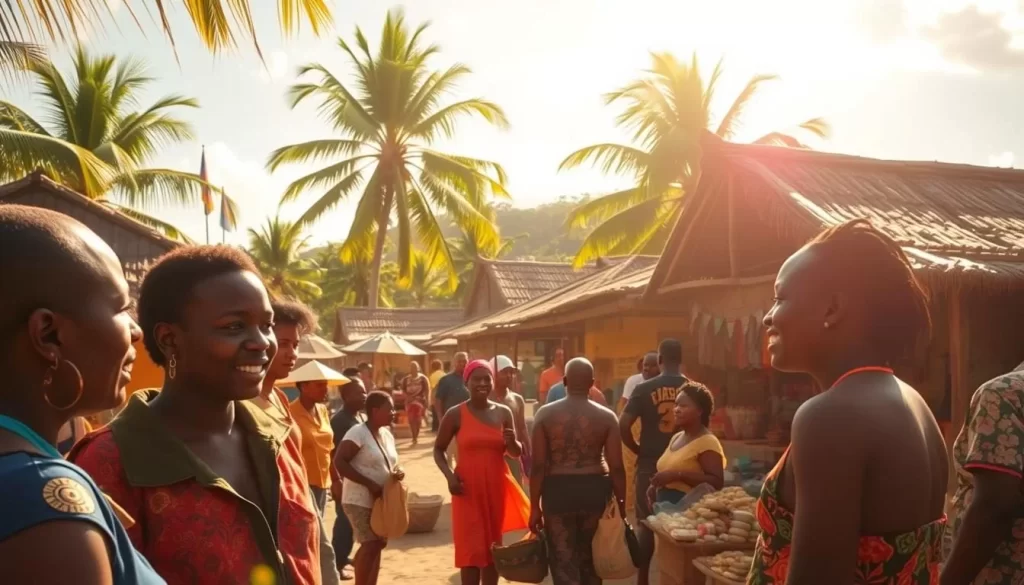
Forro Creole and Its Cultural Roots
Forro Creole is a linguistic group that unites people across the islands. Spoken by 36.2% of the population, it serves as a bridge between African traditions and Portuguese influence. Its lexicon is 93% derived from Portuguese, with the remaining 7% rooted in African languages.
This creole thrives in coastal communities, where it’s a vital part of daily life. Despite its oral nature and lack of standard orthography, Forro remains a symbol of identity for many. Its lexical similarity to other creoles, like Angolar and Principense, highlights the shared history of these languages.
Preservation Challenges for Angolar and Principense
Angolar and Principense face significant preservation challenges. Angolar, spoken by 6.6% of the population, is still considered vigorous but is at risk of decline. Principense, on the other hand, is nearly extinct, with only a handful of speakers remaining.
Efforts to revitalize these languages are crucial. They represent the islands’ linguistic diversity and cultural richness. Programs focusing on education and community engagement could help ensure their survival for future generations.
For more insights into the linguistic evolution of these creoles, explore this detailed study. Additionally, learn about their phonological development to understand their unique traits.
Foreign Languages and Educational Impact
In São Tomé and Príncipe, education opens doors to global opportunities through foreign language learning. English and French are the top foreign languages taught in schools, reflecting the country’s commitment to global communication and educational advancement. These languages are not just subjects—they are tools for personal and community growth.

Learning English and French in Schools
English and French are integrated into the school curricula from an early age. This approach helps students develop proficiency in these languages, preparing them for a globalized world. The focus on foreign language education broadens opportunities for residents, especially in fields like tourism, trade, and international relations.
However, teaching foreign languages comes with challenges. Limited resources and teacher training can impact the quality of instruction. Despite these hurdles, the benefits are clear. Students gain valuable skills that enhance their career prospects and foster cultural understanding.
“Language education is not just about words—it’s about opening minds to new possibilities.”
Here’s a breakdown of how foreign languages are taught in schools:
| Language | Grade Level Introduced | Primary Focus |
|---|---|---|
| English | Primary School | Basic Communication |
| French | Secondary School | Advanced Proficiency |
Efforts to improve language education include partnerships with international organizations. These collaborations aim to provide better resources and training for teachers. For more insights into the country’s educational challenges, visit this detailed analysis.
Foreign language education in São Tomé and Príncipe is more than a curriculum requirement—it’s a pathway to global participation. By investing in these skills, the country empowers its residents to thrive in an interconnected world.
Historical Influences and Evolution of Language
From colonization to independence, the islands’ languages tell a tale of resilience and adaptation. The linguistic diversity you see today is a result of centuries of cultural fusion and historical events.
Colonial Legacies and Linguistic Diversity
The Portuguese colonization in the 15th century introduced the official language, Portuguese, which remains dominant today. Over the years, the islands’ demographics evolved, blending African, European, and creole influences. This mix gave rise to regional languages like Forro and Angolar, which are still spoken by significant portions of the population.
The shift from creole languages to Portuguese began in the late 19th century due to the arrival of contract laborers. This process intensified from the 1960s, coinciding with the rise of the nationalist movement and the country’s independence in 1975. These events marked a turning point in the linguistic landscape, shaping the identity of São Tomé and Príncipe.
Today, Portuguese is spoken by 98.4% of the population, while creole variants like Forro and Angolar hold cultural significance in rural areas. The development of Santomean Portuguese reflects a blend of creole heritage, colonial influences, and contemporary innovations.
Understanding these historical influences helps you appreciate the islands’ linguistic richness. It’s a story of resilience, adaptation, and unity that continues to shape their cultural identity.
Conclusion
The linguistic heritage of these islands is a vibrant tapestry of history and culture. Portuguese, spoken by 98.4% of the inhabitants, serves as a unifying force in governance and education. Alongside it, creole languages like Forro and Angolar add depth to the cultural content, preserving traditions in rural areas.
Foreign language education further enriches this dynamic, offering global opportunities for residents. At every station of life, from schools to communities, these languages shape identity and connection. They reflect resilience and adaptation, bridging the past and present.
Exploring this linguistic diversity invites you to appreciate the unique content of these islands. For deeper insights, visit this detailed analysis. Each language tells a story, contributing to the rich cultural fabric of the inhabitants.
The above is subject to change.
Check back often to TRAVEL.COM for the latest travel tips and deals.
Here are some Tours & Sightseeing suggestions that might pique your interests!
